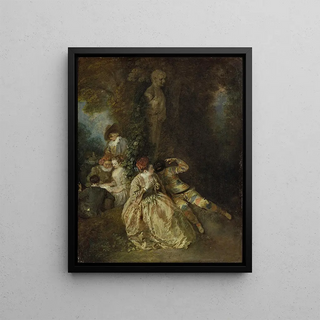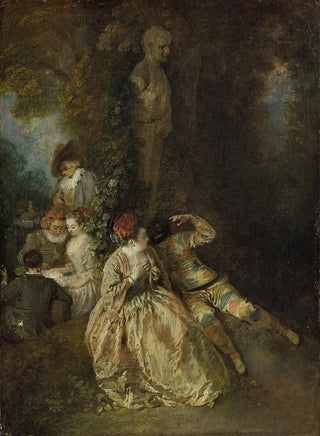Art print | Do you want to triumph over the beauties - Jean-Antoine Watteau


View from behind

Frame (optional)
Do you want to triumph over the Beauties - Jean-Antoine Watteau – Captivating introduction
In the world of art, some works transcend time and space, captivating minds and awakening emotions. "Do you want to triumph over the Beauties" by Jean-Antoine Watteau is one of these creations. Painted in the early 18th century, this iconic piece embodies the spirit of Rococo, an artistic movement that celebrates lightness, elegance, and sensuality. Through this canvas, Watteau immerses us in a universe where beauty and seduction intertwine, inviting viewers to reflect on the fleeting pleasures of life. The art print of Do you want to triumph over the Beauties - Jean-Antoine Watteau allows everyone to access this unique visual experience, while offering a window into the soul of an unparalleled artist.
Style and uniqueness of the work
Watteau's style is immediately recognizable, marked by delicate colors and harmonious compositions. In "Do you want to triumph over the Beauties," he deploys a palette of pastel shades that evoke the softness of fleeting moments. The characters, dressed in refined costumes, are arranged in a setting that is both intimate and festive, where lush nature seems to invite dance. The lightness of gestures and the expression of faces testify to a rare sensitivity, making the work all the more lively. Watteau excels in the art of capturing subtle emotions, and each gaze upon this canvas reveals new facets of his message. The scene, both playful and melancholic, questions the viewer about the nature of human relationships and the passage of time, making this work a true mirror of the human condition.
The artist and his influence
Jean-Antoine Watteau, an emblematic figure of Rococo, knew how to impose his style with unmatched mastery. Born in 1684 in Valenciennes, he was influenced by Flemish and Italian masters, but quickly developed a personal approach that is uniquely his own. His ability to fuse genre painting with theatrical elements marked a turning point in art history.

Matte finish

View from behind

Frame (optional)
Do you want to triumph over the Beauties - Jean-Antoine Watteau – Captivating introduction
In the world of art, some works transcend time and space, captivating minds and awakening emotions. "Do you want to triumph over the Beauties" by Jean-Antoine Watteau is one of these creations. Painted in the early 18th century, this iconic piece embodies the spirit of Rococo, an artistic movement that celebrates lightness, elegance, and sensuality. Through this canvas, Watteau immerses us in a universe where beauty and seduction intertwine, inviting viewers to reflect on the fleeting pleasures of life. The art print of Do you want to triumph over the Beauties - Jean-Antoine Watteau allows everyone to access this unique visual experience, while offering a window into the soul of an unparalleled artist.
Style and uniqueness of the work
Watteau's style is immediately recognizable, marked by delicate colors and harmonious compositions. In "Do you want to triumph over the Beauties," he deploys a palette of pastel shades that evoke the softness of fleeting moments. The characters, dressed in refined costumes, are arranged in a setting that is both intimate and festive, where lush nature seems to invite dance. The lightness of gestures and the expression of faces testify to a rare sensitivity, making the work all the more lively. Watteau excels in the art of capturing subtle emotions, and each gaze upon this canvas reveals new facets of his message. The scene, both playful and melancholic, questions the viewer about the nature of human relationships and the passage of time, making this work a true mirror of the human condition.
The artist and his influence
Jean-Antoine Watteau, an emblematic figure of Rococo, knew how to impose his style with unmatched mastery. Born in 1684 in Valenciennes, he was influenced by Flemish and Italian masters, but quickly developed a personal approach that is uniquely his own. His ability to fuse genre painting with theatrical elements marked a turning point in art history.






